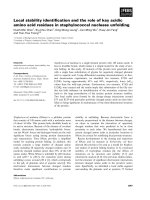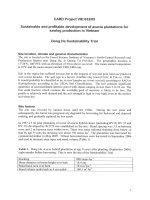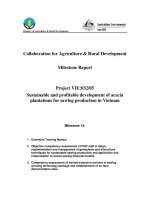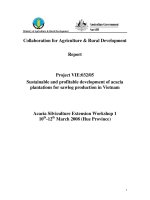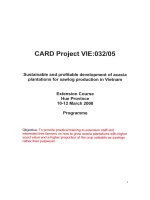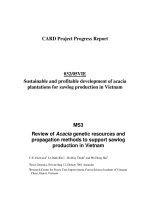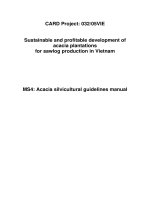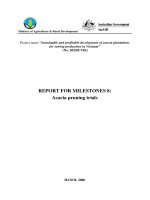Sustainable and profitable development of acacia plantations for sawlog production in Vietnam - Milestone 8 " ppt
Bạn đang xem bản rút gọn của tài liệu. Xem và tải ngay bản đầy đủ của tài liệu tại đây (401.75 KB, 9 trang )
Ministry of Agriculture & Rural Development
Project name “Sustainable and profitable development of acacia plantations
for sawlog production in Vietnam”
(No. 032/05 VIE)
REPORT FOR MILESTONES 8:
Acacia pruning trials
HANOI, 2006
Milestone 8. Acacia pruning trials
Thinning response trial, Dong Hoi
Drs Harwood and Beadle inspected candidate sites for thinning/pruning trials at Dong Hoi,
Quang Binh Province (Output 3.1) and with FSIV scientists laid out a replicated thinning
trial in a fast-growing 2-year-old clonal acacia hybrid plantation managed by the Provincial
Forest Enterprise. Subsequently, FSIV staff led by Mr Dang Thinh Trieu established this
trial successfully in May 2006, following written trial establishment guidelines provided by
Dr Beadle. All trees in the trial were pruned.
The trial has for replicates, with plots of four thinning treatments in each replicate. It should
provide valuable data on growth response to thinning of the acacia hybrid. Total area of the
trial, including external buffer rows is approximately 1.2 ha. The written guidelines for trial
establishment and management are attached as Appendix 1.
Figure 1 shows one of the thinned plots in the thinning trial shortly after establishment of the
thinning treatments.
Figure 1. Thinned plot in Dong Hoi thinning response trial
Four Demonstration pruning trials, for use in the extension and training components of the
project, were set up in Thua Thien Hue province as follows
Trial 1: Singling trial
- Species: Acacia hybrid, 1 year old
- Location: Thuy Phu, Huong Thuy, 20 km south of Hue
- Area: 0.4 hectares (0.2 ha treated, 0.2 ha adjacent plot untreated)
- Owner: Provincial Forest enterprise
- Date: September 2006
Trial 2: Form pruning trial
- Species: Acacia hybrid, 2 year old
- Location: Huong tho, Huong Tra, Hu,e 20 km west of Hue
- Area: 0.4 hectares (0.2 ha treated, 0.2 ha adjacent plot untreated)
- Owner: Provincial Forest enterprise
- Date: September 2006
Trial 3: Form pruning trial
- Species: Acacia hybrid, 2 year old
- Location: Phu Bai, Huong Thuy, 25 km south of Hue
- Area: 0.4 hectares (0.2 ha treated, 0.2 ha adjacent plot untreated)
- Owner: Provincial forest enterprise
- Date: October 2006
Trial 4: Singling trial
- Species: Acacia hybrid, 1 year old
- Location: Huong tho, Huong Tra, 20 km west of Hue
- Area: 0.4 hectares (0.2 ha treated, 0.2 ha adjacent plot untreated)
- Owner: Provincial forest enterprise
- Date: October 2006
These demonstration trials were set up by the Thua Thien Hue Provincial Forest Service,
following guidelines and under a contract funded with CARD project funds and managed by
FSIV. Dr Beadle inspected the trials in December 2006, and we will report status of these
trials in the second six-monthly Progress Report.
An additional 0.4 ha pruning trial will be established in a fast-growing 3-year-old clonal
plantation of Acacia auriculiformis at Ba Vi research station, Ha Tay province, in January
2007. This pruning trial will be of value for training/extension components of the project in
northern Vietnam.
In summary, to meet Milestone 8, one main scientific trial and four smaller demonstration
trials have already been set up in central Vietnam, and a fifth demonstration trial will be set
up shortly in northern Vietnam. Total area of trials will be 3.6 ha. The trials are all located
with easy access to good roads, and are on gently to moderately sloping land, so that training
groups can visit and work in the trials easily. Although the demonstration trials in Central
Vietnam are owned by the Thua Thien Hue Provincial Forest Enterprise, they are on land
adjacent to plantations managed by smallholder farmers and will be effective demonstration
resources for farmers.
Appendix 1. Guidelines for Dong Hoi thinning trial
Collaboration for Agriculture and
Rural Development (CARD) Program
Sustainable and profitable development of acacia plantations for sawlog
production in Vietnam
Objective 3 Output 3: Three 1-hectare thinning/pruning trials established in young
plantations, written schedule for trial management and measurement produced
Performance indicator: Thinning/pruning trials established
Means of verification: Report on trial establishment and associated guidelines
provided to CARD
Dong Hoi Thinning Trial
Background
The Dong Hoi thinning trial will be the core trial under Objective 3. Other trials will be
established later in the first year of the project in Central Vietnam and possibly later in other
parts of Vietnam, but these will be for demonstration only. The exact nature of these trials is
yet to be determined. However they are likely to be small and consist of two plots only. One
plot will represent current practice and a second plot an alternative practice incorporating
pruning and thinning. These small trials will be established in farm forests and in
cooperation with the landowner.
The site for the Dong Hoi Thinning Trial was selected on 3
rd
April 2006 and the plots marked
out next day. The plantation is located to the west of the town of Dong Hoi, is approximately
5 ha in area, and owned by Long Dai Company. It was planted to Acacia hybrid in
December 2003. Initial spacing was 4 m x 2.5 m. The trees are of remarkably good form and
the plantation is well stocked, healthy, approximately 6-to-8 m in height, and crown lift is
minimal. It is anticipated that first thinning would normally occur when trees are 8 m in
height in stands being managed for solid wood. Rates of growth are anticipated to be > MAI
20 m
3
ha
-1
yr
-1
over the rotation. A very high percentage of the trees are single-stemmed.
For all these reasons the plantation already meets the criteria that define an ideal site for
managing an Acacia stand for solid wood.
It was agreed that weed control by slashing would be undertaken across the whole area of the
trial before the thinning was undertaken. No herbicides will be used.
Objective
The main objective of this study is to quantify the effect of different levels of thinning on
height and diameter growth of Acacia hybrid. Differences in basal area increment growth
and individual tree diameter growth between treatments will be used to evaluate how to use
thinning to maximise both wood volume (basal area) and wood value (tree size).
Experimental design
Four thinning treatments will be used, including an unthinned (control) treatment (Table 1).
The reason for the large difference in stocking between the control (1000 stems ha
-1
) and the
least thinned treatment (600 stems ha
-1
) is because stocking in the unthinned treatment is
anticipated to decline during the period of the experiment because of inter-tree competition.
Because average survival is already less than 100%, average stocking in the unthinned
treatment will be less than 1000 stems ha
-1
at the start of the experiment.
The basic design is a Randomised Complete Block Design. There will be four blocks (please
note that blocks are equivalent to replicates). All four thinning treatments will be randomly
distributed within each block.
Table 1. Thinning treatments and plot sizes at Dong Ha Thinning Trial
Treatments Tree numbers per plot
-1
(stems ha
-1
) Gross Net
1000 (unthinned control) 63 35
600 38 21
450 28 16
300 19 11
Plot size (ha) 0.063 0.035
Dimensions (m × m) 28 × 22.5 20 × 17.5
1
Tree numbers per plot refer to the number of trees within each plot after thinning.
Plots
There are two types of plot:
The net plot is the area that includes 5 rows of trees, each of 7 trees in length. Trees within
this area are measured (trees in yellow background in Figure 1). Thus the net plot in the
unthinned treatment has 35 (5 rows × 7 trees) trees. The reduced numbers in the other plots
(Table 1) are representative of those required to meet the stockings for the thinned
treatments.
Figure 1. The layout of the plots (a) before thinning and (b) after thinning to 600 stems ha
-1
.
Note the net plot is yellow and the buffer area is blue. The trees removed in the thinned plot
are nominal only. The diagram illustrates the importance of distributing the final-crop trees
as evenly as possible throughout the plot. The criteria for selecting trees that should be
thinned are outlined in the text below.
6
7
5
4
3
2
1
9
8
10
11
12
13
14
20
21
19
18
17
16
15
23
22
24
25
26
27
28
34
35
33
32
31
30
29
28 m
20 m
22.5 m
17.5 m
Thinning Trial at Dong Hoi (1000 stems ha
-1
)
6
7
5
4
3
2
1
9
8
10
11
12
13
14
20
21
19
18
17
16
15
23
22
24
25
26
27
28
34
35
33
32
31
30
29
6
7
5
4
3
2
1
9
8
10
11
12
13
14
20
21
19
18
17
16
15
23
22
24
25
26
27
28
34
35
33
32
31
30
29
28 m
20 m
22.5 m
17.5 m
Thinning Trial at Dong Hoi (1000 stems ha
-1
)
5
4
3
1
9
8
11
12
13
20
19
18
15
22
24
26
27
34
35
32
29
28 m
20 m
22.5 m
17.5 m
Thinning Trial at Dong Hoi (600 stems ha
-1
)
5
4
3
1
9
8
11
12
13
20
19
18
15
22
24
26
27
34
35
32
29
28 m
20 m
22.5 m
17.5 m
Thinning Trial at Dong Hoi (600 stems ha
-1
)
The gross plot is the area that includes 7 rows of trees, each of 9 trees in length. This
includes the outer row of trees around the net plot (trees in blue background in Figure 1). In
principle all gross plots if fully stocked will have (7 rows × 9 trees) 63 trees. In the thinned
treatments these outer rows are thinned at the same intensity as the net plot so that they form
a buffer row between the net plot and the adjacent treatment.
Because the trees have been established on 4 m spacings between rows and 2.5 m spacings
between trees, the net plot size is 0.035 ha (20 × 17.5 m = 350 m
2
) and the gross plot size is
0.063 ha (28 × 22.5 m = 630 m
2
) (Table 1).
Plot layout
On 4
th
April, four blocks were marked out. Coloured tape was used to indicate the four
corners of each gross plot.
To randomise the thinning treatments within the blocks, the following procedure will be
adopted.
• For each block, go to end that is nearest the road and to its left-hand corner facing into
the block (with your back to the road). This is the reference point for each block. The
first plot will be Plot 1 and the three next plots in each block will be Plots 2, 3 and 4.
This is illustrated for the two types of block that we laid out for the experiment (Figure 2)
though not all plots are adjacent to each other.
• Randomise the four treatments within each block. This was done for Block 1 on April
4
th
. Its layout is illustrated in Figure 2.
Road
4 (300)
3 (450)
2 (1000)
1 (600)
1
24
3
Reference
point
Reference point
RoadRoad
4 (300)
3 (450)
2 (1000)
1 (600)
4 (300)
3 (450)
2 (1000)
1 (600)
1
24
31
24
3
Reference
point
Reference point
Figure 2. The two types of blocks at Dong Hoi with plot numbers. The one on the left
includes randomisation of the treatments in Block 1.
Two important points to note:
• Stocking in one or two plots in the two blocks furthest away from the road was on
occasions substantially less than 1000 stems ha
-1
because of missing trees (probably
around 850-to-900 stems ha
-1
). Care should be taken to avoid having the unthinned
(control) treatment in the worst of these plots. If this happens when the plots are
randomised within these blocks, repeat the randomisation until this problem is avoided.
• In general, the accuracy with which the trees were planted appeared to be high and the
spacing was 4 m between rows and 2.5 m between trees. However the plot sizes (see
Table 1) should be checked with a tape. If they are not within 10% of the assumed area
(630 m
2
for gross plots), then adjust the corners of the plots so that this condition is met.
The final stocking in each plot remains as indicated in Table 1 but there may be more or
less trees to choose from.
Pre-thinning measurements
The following tasks should be undertaken:
• Number the 35 trees in the net plot as indicated in Figure 1. This numbering should
include any trees that are missing.
• Measure the diameter at breast height (1.3 m) of all trees in the 16 plots.
Thinning strategy (600 stems ha
-1
)
This was discussed on site in Block 1, Plot 1 (600 stems ha
-1
) on 4
th
April. The final-crop
stocking in the net plot is to be 21 stems plot
-1
(Table 1). If this plot is fully stocked it will
have 35 stems so 14 trees have to be removed. To meet this requirement, four of the 7-tree
rows will have three trees removed, and 1 row will have two trees removed. If there are
fewer than 35 stems, then fewer trees will have to be removed.
Thin the net plot first. Thinning should be undertaken on a row-by-row basis.
Go to the row with trees 1-7 and select two trees for thinning. Repeat this exercise in trees 8-
14, 15-21, 22-28 and 29-35. Then select one more tree for thinning from four of the five
rows. The trees selected for thinning will be based on the following criteria:
First poor form
• Remove trees that are of poor form in the first 4.5 m of the stem. The main reason for
this will be large forks where the stem has split into at least two leaders. Trees of poor
form should always be removed. This should not be a problem in this trial as there are
very few of them.
• For trees that are multi-stemmed from the ground, it might be possible to retain only the
stem that is of good form in the first 4.5 m, particularly if it has a large diameter.
Small diameter
• Remove the trees of the smallest diameter.
As it is important to maximise the spacing around each retained tree, do not remove three
trees that are adjacent to each other in a row, even if these are the three smallest trees.
Aim to have the retained trees as evenly spaced as possible in the plot (see Figure 1b for a
model of what the thinned plot might look like).
Using the same criteria, thin the buffer row to the required stocking. For example, in the 600
stems ha
-1
treatment there are 63−35 = 28 trees in the buffer area if it is fully stocked (see
Table 1). After thinning, there will be 38−21 = 17 trees in the buffer area. This means that
28−17 = 11 trees have to be removed in this treatment from the buffer rows.
Follow the same protocols for the other plots and treatments using the numbers in Table 1.
Post-thinning measurements
The following measurements should be made on all trees in the net plot:
• Diameter at breast height (1.3 m) in millimetres (mm). This was done pre-thinning.
• Tree height in metres to the nearest 1/10
th
m. For example 7.6 m.
• Base of the green crown. This is measured as the point on the stem where the lowest
green branch is located.
• Green crown size. Measured as the maximum diameter of the crown along the row and
across the row. Make sure that it is always measured in this order.
After these measurements have been completed, all trees in the plots (net and gross) to be
pruned to 2.3 m. Care should be taken to remove the branches as close as possible to the
branch collar and without damaging the branch collar.
